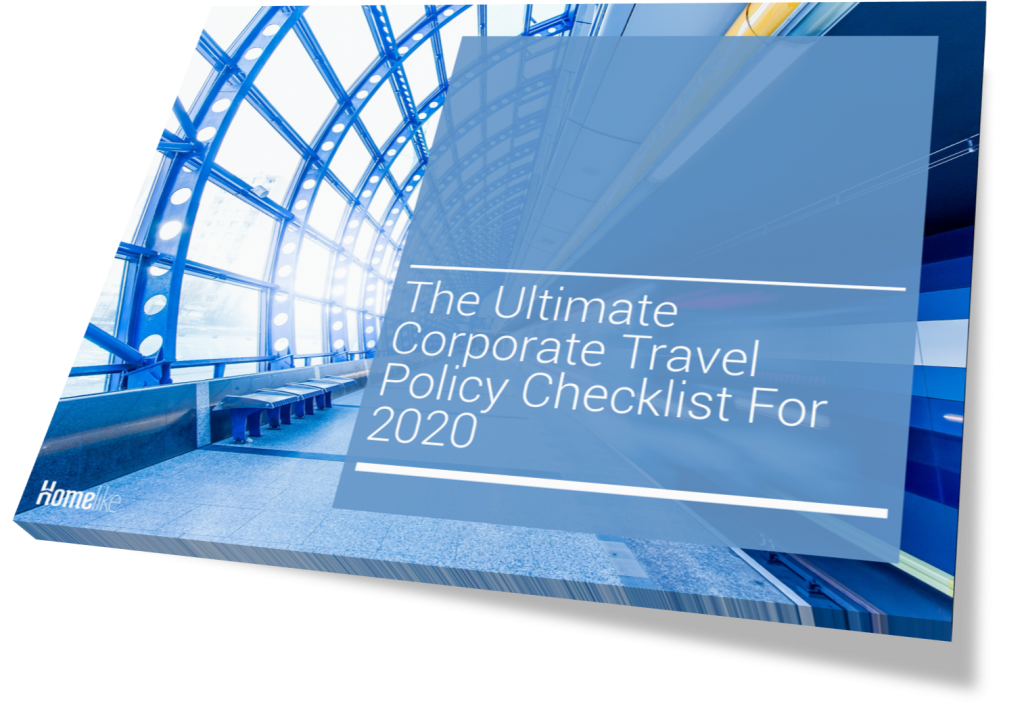10 Essential Steps to Creating a Corporate Travel Policy
Whether you’re arranging face-to-face meetings, coordinating training programs or planning for an employee relocation, it is important to have a business travel policy in place that gives specific guidelines on how to manage work-related trips. Setting out a clear process will help take the burden off your employees while making it easier to control your travel spend. Here are 10 essential steps to creating a successful corporate travel policy.
1. Outline your travel policy objectives
First and foremost, define the main objectives of your business travel policy. Is the policy meant to reduce the time your employees spend on travel arrangements? Do you want to reduce excessive business spend? Are you looking to streamline your travel planning process?
Once you have determined what you want to achieve, it will be easier to draft a well-rounded policy that gives specific guidelines on work travel management.
2. The text should be clear, comprehensible and comprehensive
What becomes apparent when talking to travel managers is that the most important criterion for a good travel policy is “clarity”. The policy must clearly state what is allowed and what is not.
In addition, the upper price limits for hotels, car bookings and food expenses must be clearly defined. Do not use vague wording such as “hotel costs will be reimbursed at an appropriate level” or “mid-range hotels should be selected”.
Vague wording may be loosely interpreted by employees which is why you need to provide specific instructions. Regulations and responsibilities must not only be crystal clear but also easy to understand and implement.
3. Encourage employees to spend responsibly
Any seasoned business traveller will tell you how much they hate overly restrictive travel policies with no room for autonomy. To avoid making your employees resentful, focus on the big picture and word your travel policy carefully.
Start out by motivating your employees to spend responsibly. Many companies are encouraging the use of apps like Rocketrip to incentivise employees to spend less on business travel.
Rocketrip uses historical data on employee spending habits to predict future spending behaviour and displays it on the screen every time an employee tries to make a booking. Then, it challenges them to beat that price and choose a lower-cost option.
Every time an employee saves a dollar by choosing cheaper accommodation or car rental over a luxury option, the app adds points to their account which can later be redeemed in the form of gift cards, credit etc.
4. Understand your travellers and their needs
A well-conceived travel policy not only helps streamline the travel process and reduce travel expenses but also takes into account employee happiness and safety.
While creating the policy, work to strike a balance between your employees’ needs and your budget limitations. Make the safety, comfort and convenience of your employees a priority. After all, happy employees deliver greater success to your business.
A common challenge in creating travel policy is that travel managers lack practical business travel experience and find it difficult to put themselves in the shoes of those affected. It is therefore essential to gather feedback from employees and find out what worked well in the past and what caused problems.
5. Room for location-based and seasonal price differences
Some cities are just more expensive than others. Your travel policy must have sufficient leeway to account for price differences between cities, seasonal cost variations and general market demand. Avoid putting your employees in a position where they have to settle for substandard lodging and travel options to slash your travel costs.
Let’s assume you’re sending a new recruit to your New York office for a training program and your daily budget for accommodation is 200 euros per night. The average nightly rate for accommodation for a business traveller in New York is around 460 Euros.
These high costs of accommodation, along with the high prices at restaurants, can make business travel in New York City extremely pricey. In this situation, would it be fair to expect your employee to settle for a subpar hotel compromising his safety and well-being? The answer seems crystal clear, doesn’t it?
Don’t limit your employees to unreasonably low per diems forcing them to opt for roadside motels and unsafe restaurants. If you have offices or clients all over the world, business travel is unavoidable. Keep track of price fluctuations and location-specific variations while laying out your travel budget.
These are the 10 most expensive cities in the world for business travellers in 2019:
1. New York City, USA.
2. Geneva, Switzerland.
3. Zurich, Switzerland.
4. Washington DC, USA.
5. Paris, France.
6. Reykjavík, Iceland.
7. San Francisco, USA.
8. Basel, Switzerland.
9. Los Angeles, USA
10. Bern, Switzerland
HOT TIP: Renting high-quality serviced apartments at long-term rates in expensive cities and having them on standby for business travellers can generate significant cost savings over time. This option is much cheaper than business hotels.
6. Establish a clear approval process
An effective travel policy has to specify how to handle travel approvals, claims and paperwork. Your employees need to know what arrangements they can make on their own, what needs prior approval and who needs to approve them. This helps speed up business travel planning as well as the claim approval and reimbursement process.
7. Ensure the support of your company’s managers
A clear mandate from the management is recommended to ensure compliance with travel policy. The involvement of relevant departments such as HR and Finance is just as important for the creation of the policy.
In addition, all areas of the company relevant to labour, tax and travel law should be covered in order to avoid unpleasant surprises.
If a company’s senior managers set an example and follow the travel policy, this increases the motivation of less experienced employees to follow the guidelines themselves.
8. Leave room for flexibility!
A common mistake companies make is to leave no room for personalisation. Every situation is different and people have very different needs. That is why there should be room for small adjustments and personal preferences.
For example, you should give employees the option of using public transport and not require them to use rental cars if they don’t want to drive.
Similarly, some people may prefer the convenience and ease of uber and lyft over traditional taxi rental services. In other situations, furnished apartments with functional kitchens might be more suitable than a hotel room.
9. Have a travel insurance provider
Business travellers are often faced with unexpected surprises, changes in travel plans or even accidental illnesses and injury. Without proper travel insurance, this can be very expensive.
Ensure that your company has access to travel insurance solutions or a “go to” insurance service provider who provides ample coverage for unforeseen contingencies.
10. Ask for feedback and track compliance with policy
Employee feedback is invaluable when it comes to getting down to the nitty gritties of your travel policy. To know what your employees truly feel about their travel experiences, implement a feedback collection process that guarantees anonymity.
Many employees feel pressured into giving less than honest feedback for fear of causing offence to the people involved. This can be resolved by allowing them to submit feedback anonymously.
In addition, compliance with the travel policy must be regularly tracked. If it turns out that employees are not complying with the policy, the exact reasons for this must be investigated.
Are the guidelines too rigid or is the wording of the directive too vague? Does the policy convey a sense of optionality?
Where the directive does not consider the needs of employees, it misses its purpose. Only when it benefits both the company and its employees, it is an appropriate guideline for the year 2020.
What to include in your travel policy
Travel policies are meant to provide employees and travel management teams with a useful set of guidelines on how to handle various types of business travel costs. Therefore, a good travel policy must include at least the following information:
1. What expenses are covered by the company
Your business travel policy must outline the types of expenses the company is willing to bear along with relevant restrictions and guidelines. The policy must clearly stipulate at least the following:
- Preferred modes of transportation for different types of business travel
- Types of accommodation authorised for short and long term business trips
- Preferred suppliers and service providers for airline, rental car and hotel bookings
- Travel booking systems and tools to be used
2. What expenses are non-refundable
A well-designed policy must also clearly define the list of expenses that are considered personal, that the company is not willing to reimburse. Here are a few examples of items that are usually considered non-refundable:
- Alcoholic beverages
- Airline upgrade fees
- Personal trips made during business travel
- Tips paid to restaurant or hotel staff
- Charter flights
- Extra luggage
3. How to get travel plans approved
When it comes to travel plan approvals, it is necessary to have a structured approach. Every employee should be given information on how to prepare and submit detailed travel plans and how to get them approved.
Clear hierarchies must be established for approval of travel requests, plans and reimbursement to improve the efficiency of the workflow. At any given time, a travelling employee must have information about the right person to contact for a work travel-related question without having to approach a million different people.
4. How to report travel expenses and file claims
It is important for your employees to have a clearly defined expense reporting process so that they can claim back their money without any hassles.
The policy must specifically state how to file expense reports and reimbursement claims.
- What is the timeline for submitting expense reports
- What expense categories need prior authorisation
- What original receipts need to be submitted
- Who approves claims and expense reports
5. What are the expense limits for various categories
In general, most employees are committed to doing justice to their employers and many companies have found that giving employees more autonomy can actually reduce wasteful spending habits.
Try to find a healthy compromise to show employees that you trust their discretion while also setting realistic spending limits at the same time.
Your policy must stipulate spending limits for various types of expenses especially the following:
- Airfare and ground transportation such as rental cars, taxis, shuttles etc
- Accommodation such as hotels, serviced apartments etc
- Food policy and how much is reimbursed
- Entertainment expenses
























